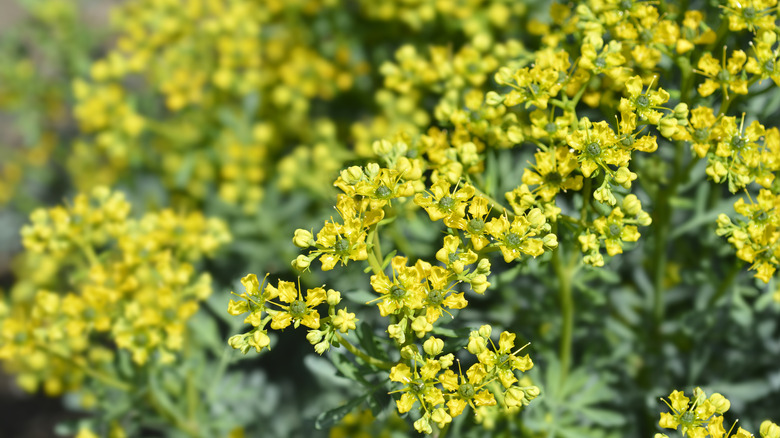The Garden Companion Plant That Keeps Pests Far Away From Your Roses
If you want to grow roses or protect your already blooming rose garden from pests, particularly Japanese beetles and ants, the rue plant is your garden's next best friend. Known scientifically as Ruta graveolens, the strong aroma from the leaves of this perennial herb is something most pests just can't stand. It's like nature's own "Keep Out" sign. By placing rue plants strategically around your rose garden, you're essentially putting up a defense mechanism. Japanese beetles are a constant headache for rose gardeners. These bugs don't just munch on the leaves; they'll go for the blossoms, too, essentially disfiguring your roses. Left uncontrolled, the impact extends beyond aesthetics; these pests can significantly hamper the health of your rose plants and, in severe cases, lead to their demise.
So why rue? The plant contains unique compounds such as rutin and coumarin. Not only do these substances contribute to the strong scent that repels pests, but they're also toxic to many insects. These chemicals are nature's way of saying, "Not today, beetles." Plus, opting for a natural solution like rue over synthetic pesticides benefits the whole ecosystem of your garden, encouraging beneficial insects to stay while deterring the harmful ones. Understanding rue as a plant—its origin, appearance, and growing conditions—increases its efficacy as a pest repellent. Knowledge is power, after all. To fully appreciate the protective qualities of rue and integrate it effectively into your rose garden, you'll want to delve deeper into what makes this plant tick.
Origins and characteristics of the rue plant
The rue plant originates from Southern Europe. Over the years, it has also made its home in various areas across the United States. The plant features bluish-green leaves and reaches a modest height of about 3 feet, making it a manageable addition to most gardens. Its feathery leaves are the powerhouses that emit a strong scent. Rue also boasts yellow flowers that bloom in the summer, adding a splash of color to your garden scheme. Interestingly, rue has a rich history of being used for medicinal purposes, although caution is advised due to its strong compounds. It has antispasmodic and anti-inflammatory properties, which have made it a subject of interest in traditional medicine. However, when it comes to your garden, its primary role will be as a guardian for your roses.
When incorporating it into your rose garden, keep in mind that rue is a perennial plant; it's here to stay, year-round. This is excellent news for your roses, especially if they're seasonal varieties. Even when the roses aren't in bloom, rue continues its vigilance, ensuring your garden remains a no-go zone for pests. Also, consider its growth habit. Unlike roses, which can spread out substantially, rue tends to grow more vertically, which allows you to make the most of your available space by planting rue in gaps between your rose bushes or along pathways that border your rose beds.
Growing rue for optimal pest control
So you're convinced that the rue plan is the stalwart defender your rose garden needs. Great! Now, how do you go about planting it in a way that maximizes its pest-repelling superpowers? First, it helps to understand its growing conditions to provide optimum care. Rue is remarkably undemanding. It prefers well-drained, even dry soil and is drought-tolerant once established. However, it appreciates regular watering during its settling-in period. Sunlight is another friend of rue; place it in a spot where it gets full sun to partial shade. If your roses enjoy similar growing conditions, you're in luck. Both plants will thrive side-by-side without competing for resources.
Now, where exactly should you plant rue to best protect your roses? Strategically positioning rue plants around the perimeters of your rose beds is a solid approach. You can also intersperse them within the rose bushes for a more diffused barrier. The aromatic compounds that deter pests are most potent when rue and roses grow nearby.
Once your rue is mature and thriving, consider harvesting some leaves to make a natural, dry insect repellent. Dry and shred the leaves, then scatter them in areas of your garden where ant activity is a concern. Rue's strong aroma and toxic compounds are as effective against ants as they are against beetles. It's another testament to this plant's versatility.


